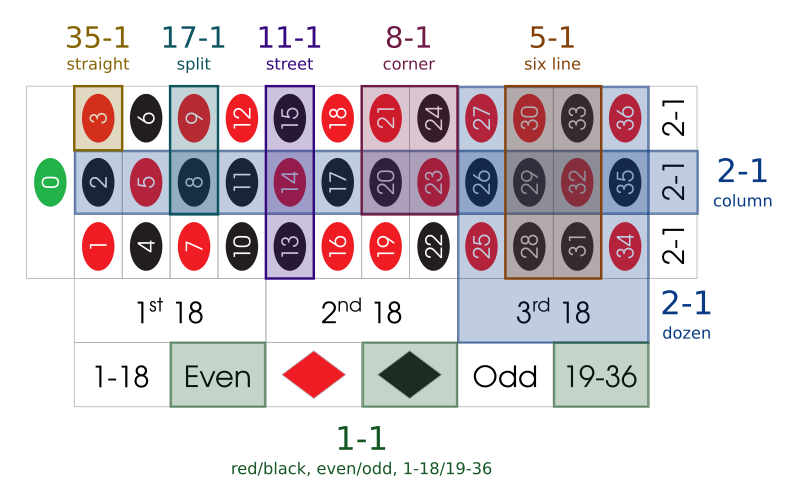How To Play Roulette
A simple explanation of roulette for beginners

Out of all of the games available in casinos, roulette is one of the easiest to pick up and play. Unlike blackjack or poker there is no skill involved; you just make bets on where you think a ball is going to land when it stops spinning around a wheel.
Anyway, most people will be familiar with how it works, but even if you aren't, you probably still recognize the wheel and general appearance of the game. So, for those of you not quite sure of how roulette is played, here's a quick and simple guide on how to play roulette.
1. The Wheel

The core part of any roulette table is the wheel. The roulette wheel normally consists of 36 numbers from 1 to 36, with each alternating between black and red in color as you move around the wheel. There will also either be a single green 0 or a green 0 and 00 depending on whether you are playing at a European or American Roulette table.
For each game, the wheel is spun and a ball is sent travelling around the edge of the roulette wheel in the opposite direction. After some time, gravity takes hold and both the wheel and ball slow down, allowing the ball to come to rest at a particular point on the wheel. The ball will fall into one of the pockets numbered 1 to 36, or into the 0 (or 00 if available).
This result will determines who the winners of the game are. Winners are paid their winnings, and losing bets are collected by the casino. Players then make new bets, and the wheel is spun again.
2. The Table

You have a number of betting options at the roulette table. The betting area contains a grid filled with number 1 to 36 with an additional 0 and 00 if available, which correspond to the numbers on the roulette wheel itself.
Players can bet on different number within the grid, as well as betting on which color (red or black) the ball will fall into when the roulette wheel stops. In addition to this, players can spread individual bets over more than one number at a time, so that there are many possible numbers that could result in a win.
See the roulette bets and odds article for a more informative description of the different possible bets available at the roulette table.
3. The Payouts
| Bet | Other Names | Payout |
|---|---|---|
| Red / Black | Color bet | 1:1 |
| Even / Odd | 1:1 | |
| Low / High | 1-18 / 19-36 | 1:1 |
| Dozen | 2:1 | |
| Column | 2:1 | |
| 6 Number | Six line, Double street | 5:1 |
| 5 Number* | Top line, Basket, First five | 6:1 |
| 4 Number | Corner, Square | 8:1 |
| 3 Number | Street, Line | 11:1 |
| 2 Number | Split | 17:1 |
| Single Number | Straight | 35:1 |
Some bets are going to be more likely to win than others, of course, which means that the payout will increase or decrease depending on the chances of a particular bet winning. For example, a bet on one number out of 36 is far less likely to win compared to a bet on the color red, as just under half of the results of each spin will show up as red (don't forget that there is an extra green on the wheel).
Therefore the payout for choosing the correct number (35:1) will be much higher than choosing the correct color (1:1) of each spin. So in other words, the less likely the result, the bigger the payout.
Again, for a more comprehensive list of the payouts for each type of bet, check out the roulette bets article.
4. The Odds

The odds on a roulette table are displayed in a ratio form, such as 35:1, 17:1, 8:1 and so on. These numbers dictate how much each individual bet will win if they are winning bets. In general, the bigger the odds, the more money you will win if your number (or color) comes in.
For example, with 35:1 odds on a number, you will win 35 times the amount of your bet, on top of the initial bet you made. So if you placed $1 on the number 16 and the roulette ball landed in the 16 pocket on the wheel, you would win $35 on top of you initial $1 bet, returning $36 in total.
Similarly, if you wagered $5 instead of $1 and your number came in, the amount you win would still be 35 times the size of the bet, with your initial $5 added on top. Therefore a $5 on one number would return $180 in total.
Odds = 35:1
Bet = $5
Winnings = (35 * $5) + (1 * $5)
= $180
Conclusion

The fast pace, simple rules, and large wins are what make roulette an exciting and enjoyable game. And thanks to the fact that roulette is very easy to pick up, you will often find that roulette is one of the most popular games in any casino.
And like I said, roulette is a simple game, so there's not much you really need to learn. Once you've got the hang of the different types of bets and how the payouts work, you're good to go.
Ultimately the best way to learn is to just practice for free by playing online. But if you're after some further information first, check out my top tips for roulette.